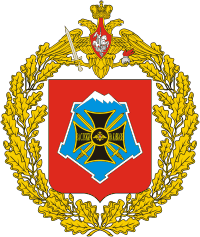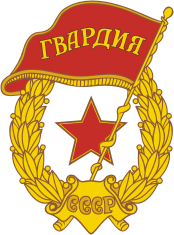The 1st Red Banner Army was a Red Army field army of World War II that served in the Soviet Far East.

The North Caucasus Military District was a military district of the Russian Armed Forces from 1992-2010. Before 1992 it had been part of the Soviet Armed Forces since 1918. In 2010 it became the Southern Military District and lately also included the Black Sea Fleet and Caspian Flotilla.
A rifle corps was a Soviet corps-level military formation during the mid-twentieth century. Rifle corps were made up of a varying number of rifle divisions, although the allocation of three rifle divisions to a rifle corps was common during the latter part of World War II.
The 3rd Shock Army was a field army of the Red Army formed during the Second World War. The "Shock" armies were created with the specific structure to engage and destroy significant enemy forces, and were reinforced with more armoured and artillery assets than other combined arms armies. Where necessary the Shock armies were reinforced with mechanised, tank, and cavalry units. During the Second World War, some Shock armies included armoured trains and air–sled equipped units.

The 38th Separate Guards Vitebskaya order of Lenin Red Banner order of Suvorov Motor Rifle Brigade is a mechanized infantry brigade of the Russian Ground Forces, part of the Eastern Military District. Military Unit в/ч 21720.
The 270th Rifle Division was a Red Army infantry division formed twice during World War II, in 1941 and 1942.

The 10th Guards Motor Rifle Division was a division of the Soviet Ground Forces. The full name of its predecessor division was the 10th Guards Rifle Pechengskii, Twice Order of the Red Banner, Order of Alexander Nevsky, Order of the Red Star Division. The 10th Guards Rifle Division was formed from the 52nd Rifle Division in late 1941.
The 27th Army was a field army of the Soviet Union's Red Army, which fought in World War II.
The 30th Rifle Division was an infantry division of the Soviet Union, formed three times. The final full name of its first formation was the 30th Rifle Irkutsk Order of Lenin, three Orders of the Red Banner, Order of the Red Banner of Labour Division of the name of the Supreme Soviet of the RSFSR. After being redesignated the 55th Guards Rifle Division in December 1942, the Second Formation of the division was recreated at Rossosh in April 1943. The division was formed a third time in 1955.
The 73rd Rifle Division was a formation of the Great Patriotic War Soviet Army. The division began assigned to the 20th Army at the beginning of the war and was destroyed and rebuilt twice before the war ended.

The 308th Rifle Division was a rifle division of the Soviet Red Army during World War II. The division was formed three separate times during the course of the war.
The 266th Rifle Division was a rifle division of the Soviet Red Army during World War II. The 266th was formed three times during the war.
The 11th Tank Division was a Soviet tank division initially formed in 1940 at Tiraspol and destroyed in 1941; it was then formed as a tank corps in May 1942. This unit was subsequently reorganized as the second formation of the 11th Tank Division in 1945.
The 67th Rifle Corps was a corps of the Red Army during World War II, formed twice.
The 34th Rifle Division was an infantry division of the Red Army during and before World War II. The division was formed in 1923. It fought in the Soviet invasion of Manchuria in August 1945. Postwar, it became the 11th Machine Gun Artillery Division.
The 207th Rifle Division began its combat path under unusual circumstances. It was partly formed for the first time as a standard Red Army rifle division in the spring of 1941, before the German invasion, but was never completed. A second formation began in April 1942 and was completed on June 1, after which it was sent to the Stalingrad Front. Heavily depleted in counterattacks against the north flank of German Sixth Army, by November the survivors were reassigned and the division disbanded. The 207th was formed for a third time in June 1943, and fought its way through the central part of the Soviet-German front, ending the war in the heart of Berlin in the battle for the Reichstag. The division saw postwar service in the Group of Soviet Forces in Germany.
The 47th Rifle Division was an infantry division of the Red Army. It was first formed in 1922 as the Georgian Rifle Division. In 1924, it became the 1st Georgian Mountain Division. The division became the 47th Georgian Mountain Rifle Division in 1936 and dropped the designation "Georgian" in 1940. It was disbanded in June 1942 after being wiped out at Izyum. In July 1942, the 47th Rifle Division was formed from the 21st Rifle Brigade. It fought in the Nevel Offensive, for which it was awarded the title "Nevel". The division was disbanded in the Baltic Military District in 1946. It was also awarded the Order of Lenin and the Order of Suvorov 2nd class. The division was reformed a third time from the 277th Rifle Division in 1955 but disbanded in July 1956.
The 295th Rifle Division was an infantry division of the Soviet Union's Red Army and later the Soviet Army, formed twice.
The 265th Motor Rifle Division was a motorized infantry division of the Soviet Army during the Cold War.
The 414th Rifle Division was twice formed as an infantry division of the Red Army; very briefly in the winter of 1941/42, then from the spring of 1942 until after May 1945. It was officially considered a Georgian National division, having nearly all its personnel of that nationality in its second formation. After its second formation it remained in service in the Caucasus near the borders of Turkey and Iran in the 44th Army until the summer of 1942, when it was redeployed to help counter the German drive toward Grozny. As German Army Group A retreated from the Caucasus in January 1943 the division was reassigned to the 37th Army in North Caucasus Front, and during the fighting in the Taman Peninsula during the summer it served in both the 58th and 18th Armies, earning a battle honor in the process. It entered the Crimea during the Kerch–Eltigen Operation in November, and was awarded the Order of the Red Banner following the offensive that liberated that region in April and May 1944, fighting in the 11th Guards Rifle Corps of the Separate Coastal Army. After the Crimea was cleared the Coastal Army remained as a garrison and the 414th stayed there for the duration of the war. Postwar, it was relocated to Tbilisi, being renumbered as the 74th Rifle Division in 1955 and disbanded the following year.



